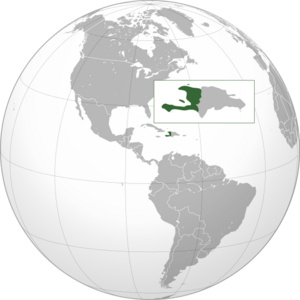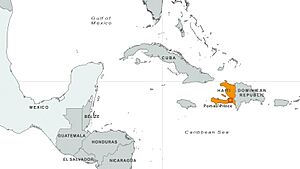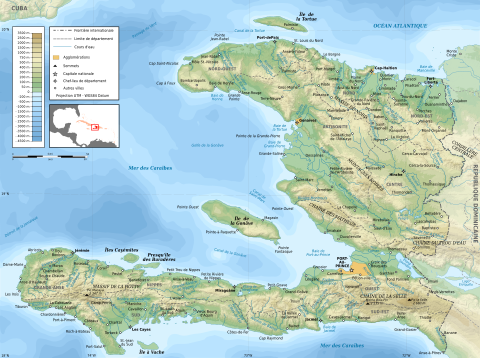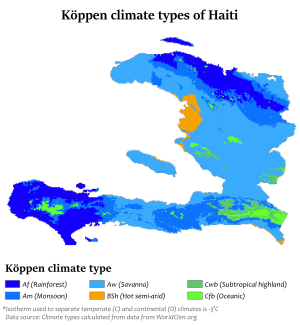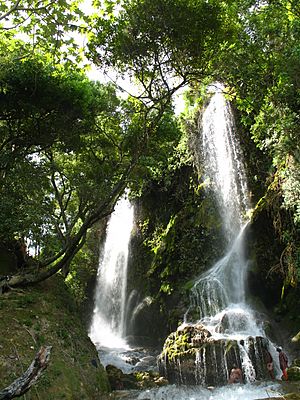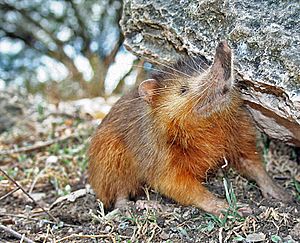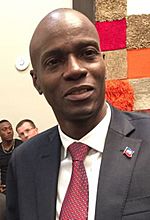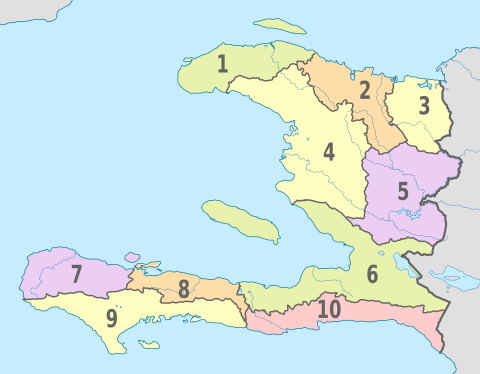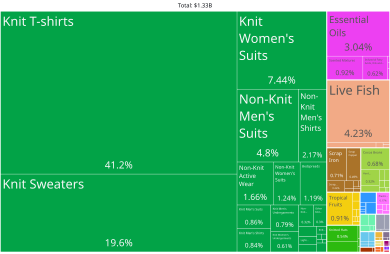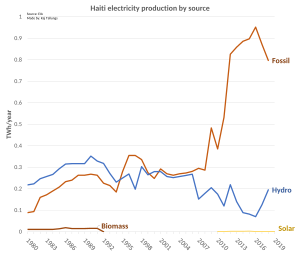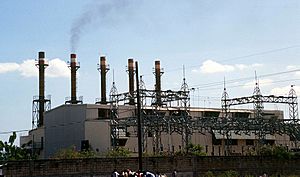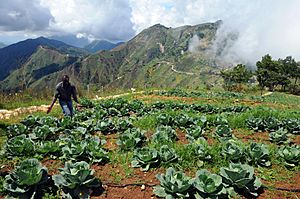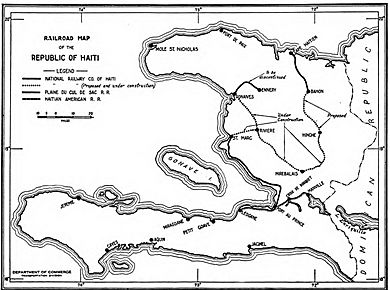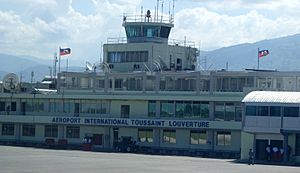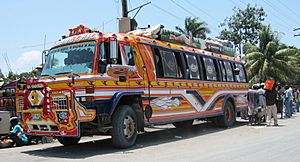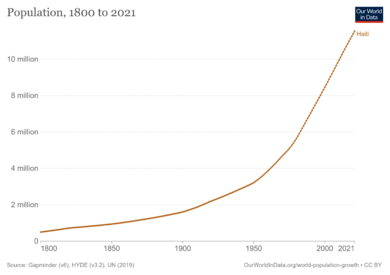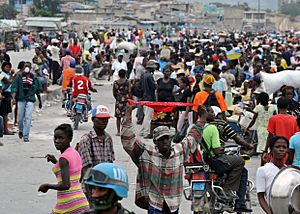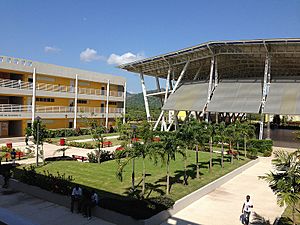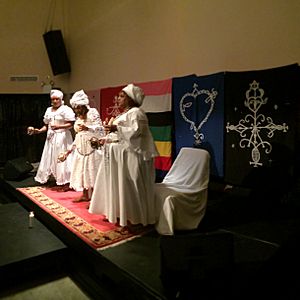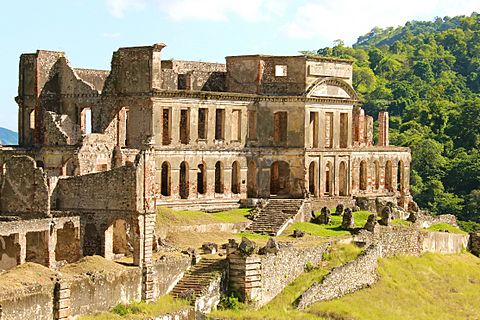Haiti facts for kids
Quick facts for kids
Republic of Haiti
|
|
|---|---|
|
Motto:
"Liberté, égalité, fraternité" (French)
Motto on traditional coat of arms:"Libète, Egalite, Fratènite" (Haitian Creole) "Liberty, Equality, Fraternity" "L'union fait la force" (French) "Inite se fòs" (Haitian Creole) "Union makes strength" |
|
| Capital and largest city
|
Port-au-Prince 18°32′N 72°20′W / 18.533°N 72.333°W |
| Official languages |
|
| Ethnic groups | 95% Black 5% Mixed or White |
| Religion
(2020)
|
|
| Demonym(s) | Haitian |
| Government | Unitary semi-presidential republic under an interim government |
|
|
| Alix Didier Fils-Aimé (acting) | |
| Legislature | National Assembly |
| Senate (vacant) | |
| Chamber of Deputies (vacant) | |
| Independence from France | |
|
• Independence declared
|
1 January 1804 |
|
• Independence recognized
|
17 April 1825 |
|
• First Empire
|
22 September 1804 |
|
• Southern Republic
|
9 March 1806 |
|
• Northern State
|
17 October 1806 |
|
• Kingdom
|
28 March 1811 |
| 9 February 1822 | |
|
• Dissolution
|
27 February 1844 |
|
• Second Empire
|
26 August 1849 |
|
• Republic
|
15 January 1859 |
| 28 July 1915 – 1 August 1934 | |
|
• Independence from the United States
|
15 August 1934 |
|
• Current constitution
|
29 March 1987 |
| Area | |
|
• Total
|
27,750 km2 (10,710 sq mi) (143rd) |
|
• Water (%)
|
0.7 |
| Population | |
|
• 2023 estimate
|
11,470,261 (83rd) |
|
• Density
|
382/km2 (989.4/sq mi) (32nd) |
| GDP (PPP) | 2023 estimate |
|
• Total
|
|
|
• Per capita
|
|
| GDP (nominal) | 2023 estimate |
|
• Total
|
|
|
• Per capita
|
|
| Gini (2012) | 41.1 medium |
| HDI (2022) | medium · 158th |
| Currency | Gourde (G) (HTG) |
| Time zone | UTC−5 (EST) |
|
• Summer (DST)
|
UTC−4 (EDT) |
| Driving side | right |
| Calling code | +509 |
| ISO 3166 code | HT |
| Internet TLD | .ht |
Haiti, officially the Republic of Haiti, is a country located on the island of Hispaniola. This island is part of the Greater Antilles group in the Caribbean Sea. Haiti shares the island with the Dominican Republic. It is east of Cuba and Jamaica, and south of The Bahamas and the Turks and Caicos Islands.
Haiti covers about 27,750 square kilometers (10,714 square miles). It is the third largest country in the Caribbean by land area. Haiti has an estimated population of 11.4 million people. This makes it the most populated country in the Caribbean. The capital city is Port-au-Prince.
The island was first home to the Taíno people. They came from South America. The first Europeans arrived on December 5, 1492, with Christopher Columbus. He thought he had found India or China. Columbus then started the first European settlement in the Americas, La Navidad, on what is now Haiti's northeastern coast.
Spain claimed the island and named it La Española. It was part of the Spanish Empire until the early 1600s. Later, the western part of the island was given to France in 1697. It was then called Saint-Domingue. French colonists created rich sugarcane plantations. Many enslaved people from Africa worked on these farms. This made the colony one of the wealthiest in the world.
During the French Revolution (1789–99), enslaved people and free people of color started the Haitian Revolution (1791–1804). Toussaint Louverture, a former enslaved person, led this fight. After 12 years, Napoleon Bonaparte's forces were defeated. Jean-Jacques Dessalines (who later became Emperor Jacques I) declared Haiti's independence on January 1, 1804.
Haiti was the first independent country in Latin America and the Caribbean. It was also the second republic in the Americas. It was the first country in the Americas to end slavery. Haiti is the only country in history created by a successful slave revolt. Most of Haiti's first leaders were former enslaved people.
After a short time when the country was divided, President Jean-Pierre Boyer united Haiti. He tried to control all of Hispaniola. This led to many wars that ended in the 1870s. Haiti then officially recognized the independence of the Dominican Republic.
Haiti's first 100 years of independence were often unstable. Political problems and foreign economic influence led the United States to occupy Haiti from 1915 to 1934. After several short-term presidents, François Duvalier took power in 1956. His son, Jean-Claude Duvalier, continued his rule until 1986. This time was marked by violence against opponents, corruption, and economic problems. After 1986, Haiti tried to become more democratic.
Haiti is a founding member of the United Nations. It is also part of the Organization of American States (OAS) and the Association of Caribbean States. Haiti is a member of the International Monetary Fund and the World Trade Organization. Haiti has faced many challenges. These include a coup d'état and a terrible earthquake that killed over 250,000 people. There was also a cholera outbreak.
Haiti has been facing a difficult time recently. This includes protests, hunger, and more gang activity. As of early 2023, Haiti does not have elected government officials. It has been described as a failed state.
Contents
- What Does the Name Haiti Mean?
- Exploring Haiti's Geography
- How Haiti's Government Works
- Haiti's Economy and How People Live
- Getting Around Haiti: Transportation
- People and Culture in Haiti
- Haiti's Rich Culture
- Haitian Art: Colors and Stories
- Music and Dance: A Mix of Influences
- Haitian Literature: Stories and Poems
- Haitian Cinema: Films and Documentaries
- Delicious Haitian Cuisine
- Architecture: Historic Buildings
- Museums: Preserving History
- Folklore and Mythology: Stories and Beliefs
- National Holidays and Festivals
- Sports: Football and More
- See also
What Does the Name Haiti Mean?
The name Haiti comes from the Taíno language. It means "land of high mountains." This name was used for the entire island of Hispaniola. Haitian revolutionary Jean-Jacques Dessalines brought back this name for independent Saint-Domingue. It was a way to honor the island's first people.
In French, the ï in Haïti means the vowels are pronounced separately. The H is silent. In English, the most common way to say it is HAY-ti.
Haiti was once called the "Pearl of the Antilles" (La Perle des Antilles). This was because of its natural beauty and the wealth it created for France. In the 1700s, the colony was the world's top producer of sugar and coffee.
In Haitian Creole, the name is spelled and said as Ayiti.
Exploring Haiti's Geography
Haiti makes up the western three-eighths of Hispaniola. This is the second largest island in the Greater Antilles. Haiti is 27,750 square kilometers (10,714 square miles) in size. It is the third largest country in the Caribbean, after Cuba and the Dominican Republic. Haiti shares a 360-kilometer (224-mile) border with the Dominican Republic. Haiti has a long coastline, about 1,771 kilometers (1,100 miles) long. Only Cuba has a longer coastline in the Greater Antilles.
Haiti is the most mountainous country in the Caribbean. Its land has mountains mixed with small coastal plains and river valleys. The weather is tropical, but it changes depending on how high up you are. The highest point is Pic la Selle, which is 2,680 meters (8,793 feet) tall.
Regions of Haiti
The northern part of Haiti is called the Marien Region. It includes the Massif du Nord (Northern Massif) and the Plaine du Nord (Northern Plain). The Massif du Nord is a mountain range that stretches from the Dominican Republic. The Plaine du Nord is a lowland area along the northern border.
The central part is the Artibonite Region. It has two plains and two mountain ranges. The Plateau Central (Central Plateau) runs along the Guayamouc River. To its southwest are the Montagnes Noires. Haiti's most important farming valley is the Plaine de l'Artibonite. It lies between the Montagnes Noires and the Chaîne des Matheux.
This region has Haiti's longest river, the Riviere l'Artibonite. It starts in the Dominican Republic and flows through central Haiti. It then empties into the Golfe de la Gonâve. Haiti's second largest lake, Lac de Péligre, is also in this valley. It was formed by the Péligre Dam in the 1950s.
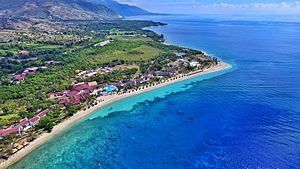
The southern part is the Xaragua Region. It includes the Plaine du Cul-de-Sac and the mountainous southern peninsula. The Plaine du Cul-de-Sac is a low area with salty lakes. Haiti's largest lake, Étang Saumatre, is here. The Chaîne de la Selle mountain range runs from east to west.
Islands Around Haiti
Haiti also has several islands off its coast. Tortuga (Île de la Tortue) is off the northern coast. La Gonâve is in the Golfe de la Gonâve. It is Haiti's largest island and has many rural villagers. Île à Vache (Cow Island) is off the southwest coast. The Cayemites are also in the Gulf of Gonâve.
La Navasse (Navassa Island) is west of Jérémie. Both Haiti and the United States claim this island. The U.S. currently manages it.
Haiti's Climate and Weather
Haiti has a tropical climate. The temperature changes a bit depending on how high up you are. In Port-au-Prince, temperatures range from 23°C (73°F) to 31°C (88°F) in January. In July, they range from 25°C (77°F) to 35°C (95°F).
Rainfall varies across the country. Lowlands and mountain slopes get more rain. Haiti's dry season is from November to January. Port-au-Prince gets about 1,370 mm (54 inches) of rain each year. There are two rainy seasons: April–June and October–November. Haiti often experiences droughts and floods. These are made worse by the loss of forests. Hurricanes are also a threat, and the country is prone to earthquakes.
Understanding Haiti's Geology
Haiti sits on top of the Enriquillo-Plantain Garden fault zone. This is where the Caribbean tectonic plate moves east. It shifts about 20 mm (0.79 inches) each year compared to the North American plate. This fault system has two branches in Haiti.
Scientists had warned about the risk of a major earthquake. A study in 2007 noted that the Enriquillo-Plantain Garden fault zone could be ready for a large earthquake. On January 12, 2010, a magnitude 7.0 2010 Haiti earthquake happened on this fault zone.
Haiti also has rare elements like gold. Gold can be found at The Mont Organisé gold mine. Haiti does not have any active volcanoes.
Haiti's Environment and Nature

The loss of forests and soil erosion cause severe flooding in Haiti. For example, floods in May 2004 killed over 3,000 people.
About 50 years ago, 60% of Haiti was covered in forests. Now, about 30% of the country has tree cover. This is a big difference from older, incorrect estimates of only 2%. Scientists are working on the Haiti Regenerative Initiative. This project aims to reduce poverty and natural disaster risks. It does this by restoring ecosystems and managing resources sustainably.
Haiti's Amazing Biodiversity
Haiti has a wide variety of plant life. This is because of its mountains and different climate zones. Important trees include the breadfruit tree, mango tree, acacia, mahogany, and coconut palm. Forests used to be much larger but have been greatly reduced.
Most mammal species in Haiti are not native. They were brought to the island after colonial times. However, there are native bat species. The Hispaniolan hutia and Hispaniolan solenodon are unique to the island. Various whale and dolphin species live off Haiti's coast.
Over 260 bird species live in Haiti. 31 of these are found only on Hispaniola. Notable birds include the Hispaniolan trogon and the Hispaniolan parakeet. There are also birds of prey, pelicans, and hummingbirds.
Reptiles are common. Examples include the rhinoceros iguana, Haitian boa, and American crocodile.
How Haiti's Government Works
Haiti has a semi-presidential republic. This means the president of Haiti is the head of state. The president is chosen by popular elections every five years. The prime minister is the head of government. The president appoints the prime minister from the main party in the National Assembly.
The president and prime minister share executive power. Legislative power belongs to the government and the two parts of the National Assembly of Haiti. These are the Senate and the Chamber of Deputies. Haiti's government is unitary. This means the central government gives powers to the departments. The current political system is based on the Constitution of Haiti from March 29, 1987.
Haitian politics have often been challenging. Since independence, Haiti has had 32 coups. Haiti is the only country in the Western Hemisphere to have a successful slave revolution. However, long periods of rule by leaders like François Duvalier and his son Jean-Claude Duvalier have affected the nation. Since the Duvalier era ended, Haiti has been working towards a democratic system.
Haiti's Administrative Divisions
Haiti is divided into ten departments. Each department has a capital city.
- Nord-Ouest (Port-de-Paix)
- Nord (Cap-Haïtien)
- Nord-Est (Fort-Liberté)
- Artibonite (Gonaïves)
- Centre (Hinche)
- Ouest (Port-au-Prince)
- Grand'Anse (Jérémie)
- Nippes (Miragoâne)
- Sud (Les Cayes)
- Sud-Est (Jacmel)
These departments are further divided into 42 arrondissements. Then there are 145 communes and 571 communal sections. These are like smaller local government areas.
Haiti's Relationships with Other Countries
Haiti is a member of many international groups. These include the United Nations, CARICOM, and the International Monetary Fund. It is also part of the Organisation of American States and the World Trade Organization.
In 2012, Haiti wanted to become a full member of the African Union (AU). The AU was planning to upgrade Haiti's status.
Haiti's Military and Police
Haiti has a long military history. The Indigenous Army was important in building the state. Until the 20th century, every Haitian president was an army officer. The army was later renamed the Haitian National Police (PNH). In 2018, President Jovenel Moise brought back the armed forces.
Haiti's Ministry of Defense manages the armed forces. The former Haitian Armed Forces were ended in 1995. However, efforts to bring them back are happening now. The main defense force for Haiti is the Haitian National Police. They have a highly trained SWAT team and work with the Haitian Coast Guard. In 2010, the police force had 7,000 members.
Haiti's Economy and How People Live
Haiti's economy is mostly controlled by the state. It ranks 145th out of 177 countries in a "freedom index." Haiti is one of the poorest countries in the Americas. This is due to corruption, political instability, and a lack of good infrastructure. Many Haitians try to move to other countries for better opportunities.
After the 2010 earthquake and a cholera outbreak, trade decreased a lot. Haiti's economy grew by 1.5% in 2005 after a period of decline. In 2009, Haiti qualified for its external debt to be cancelled. This was through a program by the IMF and World Bank.
Most of the government's budget comes from an agreement with Petrocaribe. This is an oil alliance led by Venezuela.
Help from Other Countries
Haiti has received a lot of aid from other countries. From 1990 to 2003, it got over US$4 billion in aid. The United States is the biggest donor. After the 2010 earthquake, US President Barack Obama promised US$1.15 billion in help. European Union nations pledged over €400 million. The neighboring Dominican Republic also provided a lot of humanitarian aid. This included building a university and offering free healthcare.
The United Nations said that US$13.34 billion was set aside for rebuilding after the earthquake. However, two years later, less than half of that money had been released. As of 2015, the US government had given US$4 billion.
What Haiti Trades and Sells
Haiti's main import partners are the Dominican Republic, the US, and China. Haiti's main export partner is the US, receiving 83.5% of its exports. Haiti imported much more than it exported in 2011.
Energy in Haiti
In 1925, Jacmel was the first city in the Caribbean to have electricity. It was called the City of Light.
Today, Haiti relies heavily on an oil alliance with Petrocaribe for its energy. Recently, people have looked into using hydroelectric, solar, and wind energy. These are more sustainable energy sources.
As of 2017, Haiti produces the least energy in the Americas. Less than a quarter of the country has electricity. Most areas that do have energy get it from generators. These generators are often expensive and cause a lot of pollution. Areas with electricity often have daily power cuts. Some places only have electricity for 12 hours a day.
Electricity is provided by a few private companies. There is no national electricity grid. The most common energy source is wood and charcoal. Haiti uses about 4 million metric tons of wood products each year. Petroleum is also important, and all fuel is imported.
In 2018, officials announced a project for 24-hour electricity. To reach this goal, much more power needs to be installed. Currently, only 27.5% of the population has access to electricity.
How People Earn Money in Haiti
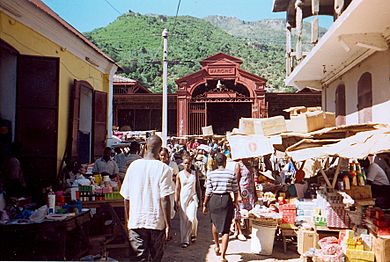
Haiti has a shortage of skilled workers. Many people are unemployed or underemployed. Most Haitians work in informal jobs. Three-quarters of the population lives on US$2 or less per day.
Money sent by Haitians living abroad is the main source of foreign money. This equals one-fifth (20%) of Haiti's total economic output. It is more than five times what Haiti earns from exports. In 2004, 80% or more of college graduates from Haiti lived abroad.
Sometimes, families who cannot afford to care for their children send them to live with wealthier families. These children are called restavek, or house servants. The wealthier family is supposed to provide education, food, and shelter. However, this system can sometimes be misused.
Homes and Housing
In rural areas, people often live in wooden huts with metal roofs. Outdoor toilets are usually behind the huts. In Port-au-Prince, colorful shantytowns surround the city and go up the mountainsides.
Middle and upper-class people live in suburbs or city apartments. Their houses are often like small forts. They are behind walls with spikes, barbed wire, or broken glass. The gates are locked at night, and guard dogs patrol the yard. These houses often have backup generators because the electricity is not reliable. Some even have water tanks on their roofs because the water supply can also be unreliable.
Farming and Agriculture
Haiti is the world's top producer of vetiver. This root plant is used to make luxury perfumes and essential oils. It provides half of the world's supply. About 40–50% of Haitians work in farming. However, only 11.3% of the land is very good for crops. Haiti imports half of its food needs, including 80% of its rice.
Haiti exports crops like mangoes, cacao, coffee, and papayas. Farm products make up 6% of all exports. Local crops include maize, beans, cassava, sweet potato, and bananas.
Haiti's Money
The Haitian gourde (HTG) is the national money. A "Haitian dollar" is equal to 5 gourdes. This is an informal price used for some things. Most businesses and people in Haiti also accept US dollars. However, in outdoor markets, gourdes might be preferred. Locals might call the US dollar "dollar américain" or "dollar US."
Tourism in Haiti
Haiti's tourism market is still developing. The government is working hard to promote it. Haiti has many things that attract tourists to other Caribbean places. These include white sand beaches, mountains, and warm weather all year. However, the country's image has made it harder for tourism to grow. In 2014, Haiti had 1,250,000 tourists, mostly from cruise ships. The industry made US$200 million that year.
Several new hotels opened in 2014. These included a Best Western Premier and a five-star Royal Oasis hotel. A four-star Marriott Hotel also opened in Port-au-Prince. New hotels are also being built in other cities like Les Cayes and Cap-Haïtien.
The Haitian Carnival is one of the most popular carnivals in the Caribbean. In 2010, the government decided to hold the event in a different city each year. This was to spread tourism around the country. The National Carnival usually happens in Port-au-Prince, Cap-Haïtien, or Les Cayes. It follows the popular Jacmel Carnival, which takes place a week earlier.
Caracol Industrial Park
On October 21, 2012, leaders opened the Caracol industrial park. It is the largest in the Caribbean. This project cost US$300 million. It includes a power plant, a water-treatment plant, and housing for workers. It aims to create 65,000 jobs in northern Haiti.
The park is part of a bigger plan for Haiti's North and North-East departments. This plan includes making the Cap-Haïtien International Airport bigger. It also involves building an international seaport in Fort-Liberté. A new university campus, Roi Henri Christophe Campus, opened in Limonade in 2012.
A South Korean clothing company, Sae-A Trading Co. Ltd, is a main tenant. It has created 5,000 jobs and built 8,600 houses for its workers. The industrial park could create up to 65,000 jobs when fully developed.
Getting Around Haiti: Transportation
Haiti has two main highways that cross the country. Route Nationale No. 1 goes from Port-au-Prince to Cap-Haïtien. Route Nationale No. 2 connects Port-au-Prince with Les Cayes. The roads in Haiti are generally in poor condition. Many have potholes and can become impassable in bad weather.
The port in Port-au-Prince, Port international de Port-au-Prince, handles most shipping. It has cranes, large berths, and warehouses, but these are not in good shape. The port is not used as much as it could be. The port of Saint-Marc is often preferred for consumer goods. This is because it is away from busy Port-au-Prince.
In the past, Haiti used trains. However, the train system was not well-maintained. It would cost too much to fix it now. In 2018, there was a proposal for a railway between Haiti and the Dominican Republic.
Airports in Haiti
Toussaint Louverture International Airport is near Port-au-Prince. It is the main airport for flights into and out of Haiti. Along with Cap-Haïtien International Airport, it handles most international flights. Smaller airports in cities like Jacmel and Jérémie are used by regional airlines and private planes.
In 2013, there were plans to build an international airport on Île-à-Vache.
Bus Service: Tap Taps
Tap tap buses are brightly painted buses or pickup trucks. They work like shared taxis. The name "tap tap" comes from passengers tapping on the bus to say they want to get off. These vehicles are often privately owned and decorated. They follow set routes and only leave when full. Passengers can usually get off anywhere. The decorations are a unique Haitian art form.
In August 2013, the first coach bus prototype was made in Haiti.
Communication in Haiti
In Haiti, people use radio, television, phones, and the Internet to communicate. Haiti ranks low in how developed its information and communication technologies are. In 2014, Haiti was 143rd out of 148 countries.
Water Supply and Sanitation
Haiti faces big challenges with water and sanitation. Access to public services is very low. The quality of these services is not good. Public institutions are still very weak, even with foreign aid. Foreign and Haitian non-governmental organizations (NGOs) play a big role in providing these services. This is especially true in rural areas and city slums.
People and Culture in Haiti
In 2018, Haiti's population was about 10,788,000. In 2006, half of the people were younger than 20. Haiti has about 350 people per square kilometer (900 per square mile). Most people live in cities, coastal plains, and valleys.
Most Haitians are descendants of former black African enslaved people. This includes Mulattoes who are mixed-race. The rest are of European or Arab descent.
Millions of people of Haitian descent live in other countries. These include the United States, the Dominican Republic, Canada, and France. There are also communities in the Bahamas, Jamaica, and Brazil.
In 2018, the average life expectancy at birth was 63.66 years.
Religion in Haiti
Religion in Haiti according to the Pew Research Center (2010) Catholicism (56.8%) Protestantism (29.6%) Unaffiliated (10.6%) Other (3%)
The 2017 CIA Factbook reported that about 54.7% of Haitians are Catholics. About 28.5% are Protestants. This includes Baptists, Pentecostals, and Seventh-day Adventists. Other sources suggest the Protestant population might be higher. Haiti has seen a growth in Protestant faiths, especially Evangelical and Pentecostal groups.
Vodou is a religion with West African roots. It is practiced by some Haitians today. It started during colonial times when enslaved people had to hide their spirits (loa) as Catholic saints. This mixing of religions is called syncretism. It is hard to know exactly how many Vodouists there are in Haiti. Vodou has been misunderstood and treated unfairly in the past. However, in 2003, the Haitian government recognized it as an official religion.
Other smaller religions in Haiti include Islam, Bahá'í Faith, Judaism, and Buddhism.
Languages Spoken in Haiti
Haiti has two official languages: French and Haitian Creole. French is the main written language and is used in government and schools. About 42% of Haitians speak French. All educated Haitians speak it, and it is used in business. Haiti is one of only two independent countries in the Americas (with Canada) that has French as an official language.
Haitian Creole is spoken by almost everyone in Haiti. Its words are 90% from French, but its grammar is like some West African languages. It also has influences from Taino, Spanish, and Portuguese. Haitians often call it Kreyòl. Haitian Creole is similar to other French creoles.
Overall, about 90–95% of Haitians speak only Haitian Creole or French fluently. More than half of the population only knows Creole.
Haitians Living Abroad
Many Haitians live in other countries. This is called the Haitian diaspora. Large communities are in the US, Canada, France, and wealthier Caribbean islands.
People from Haiti have been part of American and Canadian society since before Haiti became independent in 1804. Many important early American settlers were of Haitian origin. For example, Jean Baptiste Point du Sable, an immigrant from Saint-Domingue, founded the first non-native settlement in what is now Chicago, Illinois.
Education in Haiti
Haiti's education system is based on the French system. Higher education is managed by the Ministry of Education. It is provided by universities and other public and private schools.
More than 80% of primary schools are run by private groups. These include NGOs, churches, and for-profit operators. The government has little control over them. In 2011, Haiti had increased primary school enrollment from 47% in 1993 to 88%. Boys and girls now participate equally in education. Charity groups help by building schools and providing supplies.
According to the CIA World Factbook, Haiti's literacy rate was 60.7% in 2015. The 2010 earthquake caused a major setback for education. Many resources had to be used for survival instead.
Many people want to create a free, public, and universal education system for all primary school children in Haiti. The Inter-American Development Bank thinks it would cost at least US$3 billion to fund this system properly.
After finishing secondary school, students can go to higher education. Schools like the University of Haiti offer programs. There are also medical schools and law schools. Brown University is working with a hospital in Haiti to create a pediatric health care program.
Health and Well-being in Haiti
In the past, not many children in Haiti were vaccinated. As of 2012, 60% of children under 10 were vaccinated. This is lower than in many other countries. However, there have been large vaccination campaigns recently.
The World Health Organization says that common causes of death in Haiti include diarrheal diseases, HIV/AIDS, and respiratory infections. 90% of Haiti's children suffer from waterborne diseases and intestinal parasites. About 1.71% of Haiti's population has HIV. The rate of tuberculosis (TB) in Haiti is more than ten times higher than in the rest of Latin America. About 30,000 Haitians get malaria each year.
Most people in Haiti are at high risk for major infectious diseases. Unsafe water and poor living conditions contribute to many diseases. There is a constant shortage of healthcare workers. Hospitals also lack resources. This became very clear after the January 2010 earthquake. In 2019, the infant mortality rate in Haiti was 48.2 deaths per 1,000 live births. This is much higher than in the United States.
After the 2010 earthquake, Partners In Health built the Hôpital Universitaire de Mirebalais. It is the largest solar-powered hospital in the world.
Haiti's Largest Cities
|
Largest cities or towns in Haiti
geonames.org |
||
|---|---|---|
| Rank | Name | Pop. |
| 1 | Port-au-Prince | 1,234,742 |
| 2 | Cap-Haïtien | 534,815 |
| 3 | Carrefour (in Metro P.P.) | 442,156 |
| 4 | Delmas (in Metro P.P.) | 382,920 |
| 5 | Pétion-Ville (in Metro P.P.) | 283,052 |
| 6 | Port-de-Paix | 250,000 |
| 7 | Croix des Bouquets (in Metro P.P.) | 229,127 |
| 8 | Jacmel | 137,966 |
| 9 | Léogâne | 134,190 |
| 10 | Les Cayes | 125,799 |
Haiti's Rich Culture
Haiti has a unique culture. It mixes French and African traditions with influences from Spanish and indigenous Taíno cultures. Haiti's culture is seen in its paintings, music, and literature. Art galleries and museums in the United States and France have shown works by famous Haitian artists.
Haitian Art: Colors and Stories
Haitian art is special, especially its paintings and sculptures. It uses bright colors, simple styles, and clever humor. Haitian art often shows big, tasty foods, beautiful landscapes, market scenes, jungle animals, rituals, dances, and gods. Symbols are very important in Haitian society. For example, a rooster often represents a political figure. The red and blue colors of the Haitian flag can represent a political party.
Many artists belong to "schools" of painting. The Cap-Haïtien school shows daily life in the city. The Jacmel School shows the mountains and bays of that coastal town. The Saint-Soleil School uses abstract human forms and Vodou symbols.
In the 1920s, the indigéniste movement became famous. Its expressionist paintings were inspired by Haiti's culture and African roots. Famous painters from this movement include Hector Hyppolite and Philomé Oban. More recent artists include Edouard Duval-Carrié and Frantz Zéphirin. Sculpture is also popular. Famous sculptors include George Liautaud and Serge Jolimeau.
Music and Dance: A Mix of Influences
Haitian music combines many influences. It has French, African, and Spanish elements. There are also small influences from the native Taíno people. Music styles unique to Haiti include:
- Music from Vodou ceremonies
- Rara parade music
- Twoubadou ballads
- mini-jazz rock bands
- Rasin movement music
- Hip hop kreyòl
- méringue
- compas
Young people go to parties at nightclubs called discos. They also attend Bal, which is a formal dance.
Compas (konpa) is a complex and changing music style. It came from African rhythms and European ballroom dancing. It also mixed with Haiti's city culture. It is a refined music, with méringue as its main rhythm. Haiti did not have recorded music until 1937.
Haitian Literature: Stories and Poems
Haiti has always been a literary nation. It has produced internationally recognized poetry, novels, and plays. The French colonial experience made French the language of culture and prestige. So, French has been dominant in literary circles. However, since the 18th century, there has been an effort to write in Haitian Creole.
Recognizing Creole as an official language has led to more novels, poems, and plays in Creole. In 1975, Franketienne was the first to write a novel entirely in Haitian Creole. His book, Dezafi, gives a poetic look at Haitian life. Other well-known Haitian authors include Jean Price-Mars, Jacques Roumain, and Edwidge Danticat.
Haitian Cinema: Films and Documentaries
Haiti has a small but growing film industry. Famous directors who mostly make documentaries include Raoul Peck and Arnold Antonin. Directors who make fictional films include Patricia Benoît and Richard Senecal.
Delicious Haitian Cuisine
Haiti is known for its creole cuisine. This food is similar to Cajun cuisine. Haiti is also famous for its soup joumou.
Architecture: Historic Buildings
Important buildings include the Sans-Souci Palace and the Citadelle Laferrière. These were named a World Heritage Site in 1982. They are in the Northern Massif du Nord, in the National History Park. These buildings were among the first built after Haiti became independent from France in the early 1800s.
The Citadelle Laferrière is the largest fortress in the Americas. It is in northern Haiti. It was built between 1805 and 1820. Some Haitians call it the eighth wonder of the world.
The Institut de Sauvegarde du Patrimoine National has preserved 33 historical monuments. This includes the historic center of Cap-Haïtien. Jacmel, a colonial city, was badly damaged by the 2010 Haiti earthquake.
Museums: Preserving History
The anchor of Christopher Columbus's largest ship, the Santa María, is now in the Musée du Panthéon National Haïtien (MUPANAH). This museum is in Port-au-Prince, Haiti.
Folklore and Mythology: Stories and Beliefs
Haiti is known for its folklore traditions. Much of this comes from Haitian Vodou traditions. Belief in zombies is also common. Other folk creatures include the lougarou.
National Holidays and Festivals
The most festive time of the year in Haiti is during Carnival (called Kanaval in Haitian Creole). This happens in February. There is music, parade floats, dancing, and singing in the streets. Carnival week is traditionally a time for all-night parties.
Rara is a festival celebrated before Easter. This festival has created its own style of Carnival music.
Sports: Football and More
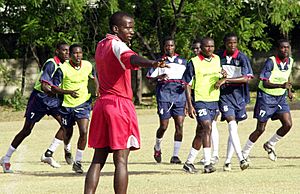
Football (soccer) is the most popular sport in Haiti. Hundreds of small football clubs play at the local level. Basketball and baseball are also becoming more popular. Stade Sylvio Cator is a multi-purpose stadium in Port-au-Prince. It is mostly used for football matches and can hold 10,000 people.
In 1974, the Haiti national football team was only the second Caribbean team to reach the World Cup. They lost in the first rounds against Italy, Poland, and Argentina. The national team won the 2007 Caribbean Nations Cup.
Haiti has participated in the Olympic Games since 1900. They have won several medals. Haitian footballer Joe Gaetjens played for the United States national team in the 1950 FIFA World Cup. He scored the winning goal in a 1–0 upset against England.
|
See also
 In Spanish: Haití para niños
In Spanish: Haití para niños




